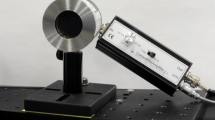Abstract
This paper presents a review of studies of the photoelectric properties of PbSnTe:In films obtained by molecular beam epitaxy and photosensitive structures in the far infrared and submillimeter ranges based on these films. The parameters of photodetector arrays of this type and detectors based on doped semiconductors and superconductors are compared. One-dimensional (2×128 elements) and two-dimensional (128 × 128 elements) PbSnTe:In based arrays with a sensitivity threshold of ~22 μm and an operating temperature of T ≤ 16 K are implemented. Under background-free conditions, the noise equivalent power (NEP) was NEP ≤ 10−18 W/Hz0.5 at T = 7 K for a black body radiation source at TBB = 77 K. In the submillimeter range of the spectrum, sensitivity to laser radiation with a wavelength λ ≤ 205 μm and a value NEP ≤ 10−12 W/Hz0.5 was observed without optimization of the design of the photosensitive element and minimization of the measurement circuit noise. The directions of the development of PbSnTe:In based radiation detectors are considered..
Similar content being viewed by others
References
W. W. Anderson, “Gain-Frequency-Current Relation for Pb1−x SnxTe Double Heterostructure Lasers,” IEEE J. Quant. Electron. 13 (7), 532–543 (1977).
M. R. Jonson, R. A. Chapman, and J. S. Wrobel, “Detectivity Limits for Diffused Junction PbSnTe Detectors,” Infrared Phys. 15 (4), 317–329 (1975).
A. G. Thompson and J. W. Wagner, “Growth and Characterization of Lead-Tin Telluride Epitaxial Layers,” Phys. Status Solidi. 5 (2), 439–448 (1971).
A. Bradford and E. Wentworth, “Preparation of Vapor Growth Lead-Tean Telluride for 8–14 Micrometer Photodiodes,” Infrared Phys. 15 (4), 303–309 (1975).
C. C. Wang and M. E. Kim, “Long-Wavelength PbSnTe/PbTe Heterostructure Mosaics,” J. Appl. Phys. 50 (5), 3733–3737 (1979).
B. A. Akimov, B. A. Brandt, S. A. Bogoslovskii, et al., “Nonequilibrium Metallic State in Pb1−x SnxTe(In) Alloys,” Pisma Zh. Eksp. Teoret. Fiz. 29 (1), 11–14 (1979).
B. M. Vul, I. D. Voronova, G. A. Kalyuzhnaya, et al., “Transfer Phenomena in Pb0,78Sn0,22Te with High Indium Content, Pisma Zh. Eksp. Teoret. Fiz. 29 (1), 21–25 (1979).
M. A. Lampert and P. Mark, Current Injection in Solids (Academic Press, New York, 1970).
A. E. Klimov and V. N. Shumsky, “Shallow Traps and the Space-Charged-Induced Limitation of the Injection Current in PbSnTe: In Narrow-Gap Ferroelectric,” Physica B. 404 (23–24), 5028–5031 (2009).
K. G. Kristovskii, A. E. Kozhanov, D. E. Dolzhenko, et al., “Photoconduction of Doped Alloys on the Basis of Lead Telluride in the Submillimeter Range,” Fiz. Tverd. Tela 46 (1), 123–125 (2004).
A. N. Akimov, V. G. Erkov, V. V. Kubarev, et al., “Photosensitivity of Pb1−x SnxTehIni Films in the Terahertz Wavelength Range,” Fiz. Tekhn. Poluprovod. 40 (2), 169–173 (2006).
D. Khokhlov, L. Ryabova, and A. Nicoric, et al., “Terahertz Photoconductivity of Pb1−x SnxTe (In),” Appl. Phys. Lett. 93, 264103 (2008).
L. I. Ryabova, A. V. Nicorici, S. N. Danilov, and D. R. Khokhlov, “Influence of Electric Current and Magnetic Field on Terahertz Photoconductivity in Pb1−x SnxTe(In),” Pisma Zh. Eksp. Teoret. Fiz. 97 (9), 607–610 (2013) [JETP Letters 97 (9), 525–527 (2013)].
A. E. Klimov and V. N. Shumsky “Far-Infrared Multielement Photoreceivers Based on In-Doped PbSnTe Heteroepitaxial Films on BaF2,” in Matrix Infrared Photodetectors (Nauka, Novosibirsk, 2001) [in Russian].
D. G. Esaev and S. P. Sinitsa “Photodetectors with Blocked Hop** Conductivity // in Matrix Infrared Photodetectors. Ed. S. P. Sinitsa (Nauka, Novosibirsk, 2001) [in Russian].
D. V. Ischenko, A. E. Klimov, I. G. Neizvestny, et al., “Temperature Resolution of Pb1−x SnxTe:In-Based Photosensing Film Structures Under Illumination with Blackbody Radiation,” in Proc. of the 15th Intern. Conf. of Young Specialists on Micro/Nanotechnologies and Electron Devices (EDM) (IEEE, Novosibirsk, 2014).
A. E. Klimov, V. V. Kubarev, N. S. Paschin, and V. N. Shumsky, “Photocurrent Dynamics in PbSnTe: In Films in the Submillimeter Spectral Range,” in Proc. of the Intern. Symp. Terahertz Radiation: Generation and Application (Novosibirsk, 2010).
A. N. Akimov, D. V. Ishchenko, A. E. Klimov, et al. “Terahertz Detectors Based on Pb1−x SnxTe: In Films,” Avtometriya 49 (5), 86–92 (2013) [Optoelectron., Instrum. Data Process. 49 (5), 492–497 (2013)].
R. R. Akberdin, E. N. Chesnokov, M. A. Dem’yanenko, et al., “High Power THz Applications on the NovoFEL,” in Proc. of the 34th Intern. Conf. on Infrared, Millimeter, and Terahertz Waves (IRMMW-THz) (Busan, Korea, 2009).
A. N. Akimov, V. G. Erkov, A. E. Klimov, et al., “Injection Currents in the Pb1−x SnxTehIni Narrow-Band Dielectric,” Fiz. Tekhm. Poluprovod. 39 (5), 563–568 (2005).
A. N. Akimov, A. E. Klimov, V. N. Shumsky, and A. L. Aseev, “Submillimeter Matrix Photosensitive Device on PbSnTe: In Films,” Avtometriya 43 (4), 63–73 (2007) [Optoelectron., Instrum. Data Process. 43 (4), 342–350 (2007)].
A. E. Klimov and V. N. Shumsky, Method of Radiation Detection by a Photodetector Array, RF Patent 2399990. Publ. 20.09.2010, Bull. No. 26.
A. Rogalski, “Infrared Detectors for the Future,” Acta Phys. Pol. A. 116 (3), 389–406 (2009).
A. E. Klimov, V. V. Kubarev, and V. N. Shumsky, “Terahertz Imaging Using Intermediate Thermal Screen,” in Proc. of the 35th Intern. Conf. on Infrared, Millimeter and Terahertz Waves (IRMMW-THz) (Rome, Italy, 2010).
I. G. Neizvestnyi, A. E. Klimov, and V. N. Shumsky, “Photon Far-Infrared and Submillimeter Array Detectors,” Usp. Fiz. Nauk 185 (10), 1031–1042 (2015).
N. Sclar, “Properties of Doped Silicon and Germanium Infrared Detectors,” Progr. Quantum Electron. 9 (3), 149–257 (1984).
J. Leotin, “Far Infrared Photoconductive Detectors,” Proc. SPIE. 0666, 81–100 (1986).
A. Rogalski and F. Sizov, “Terahertz Detectors and Focal Plane Arrays,” Opto-Electron. Rev. 19 (3), 346–404 (2011).
B. S. Karasik, S. V. Pereverzev, A. Soibel, et al., “Energy-Resolved Detection of Single Infrared Photons with λ= 8 μm Using a Superconducting Microbolometer,” Appl. Phys. Lett. 101, 052601 (2012).
Author information
Authors and Affiliations
Corresponding author
Additional information
Original Russian Text © I.G. Neizvestnyi, A.E. Klimov, V.V. Kubarev, V.N. Shumskii, 2016, published in Avtometriya, 2016, Vol. 52, No. 5, pp. 71–83.
About this article
Cite this article
Neizvestnyi, I.G., Klimov, A.E., Kubarev, V.V. et al. Radiation detectors based on PbSnTe:In films, sensitive in the terahertz range of the spectrum. Optoelectron.Instrument.Proc. 52, 462–474 (2016). https://doi.org/10.3103/S8756699016050083
Received:
Published:
Issue Date:
DOI: https://doi.org/10.3103/S8756699016050083



